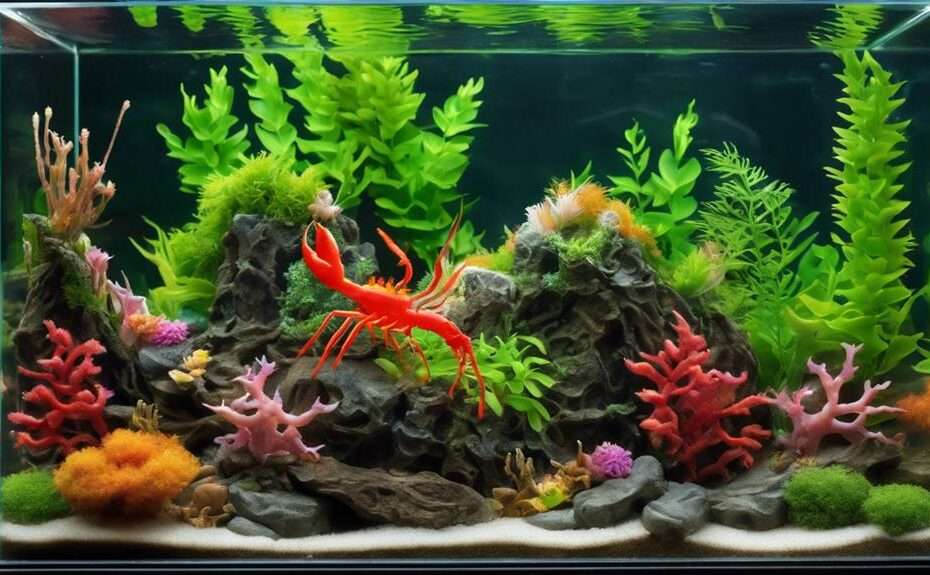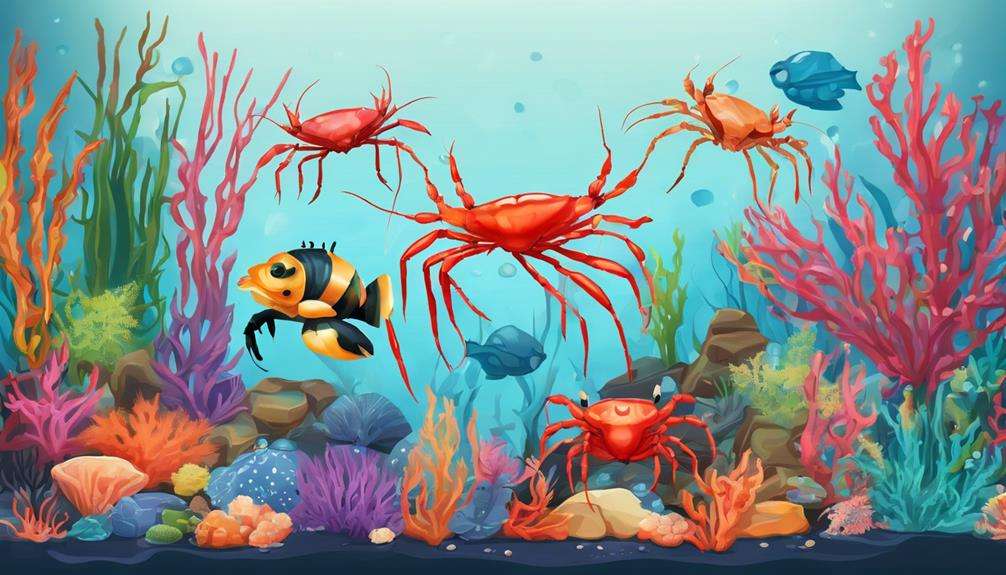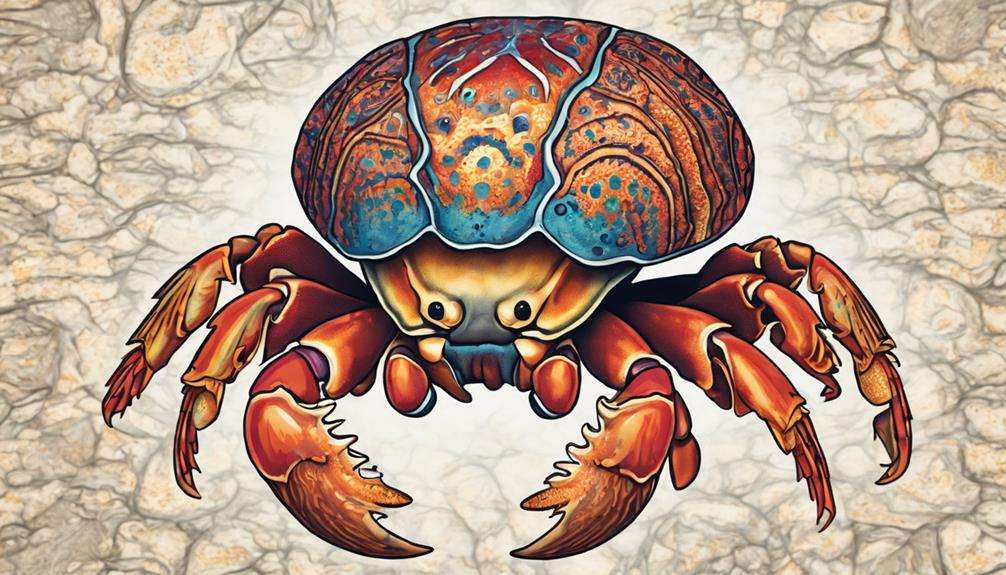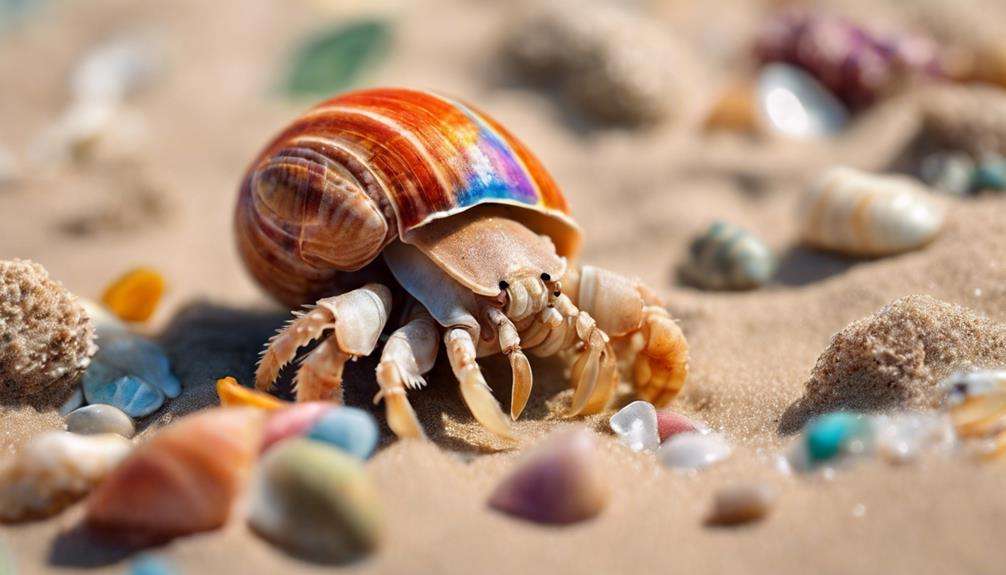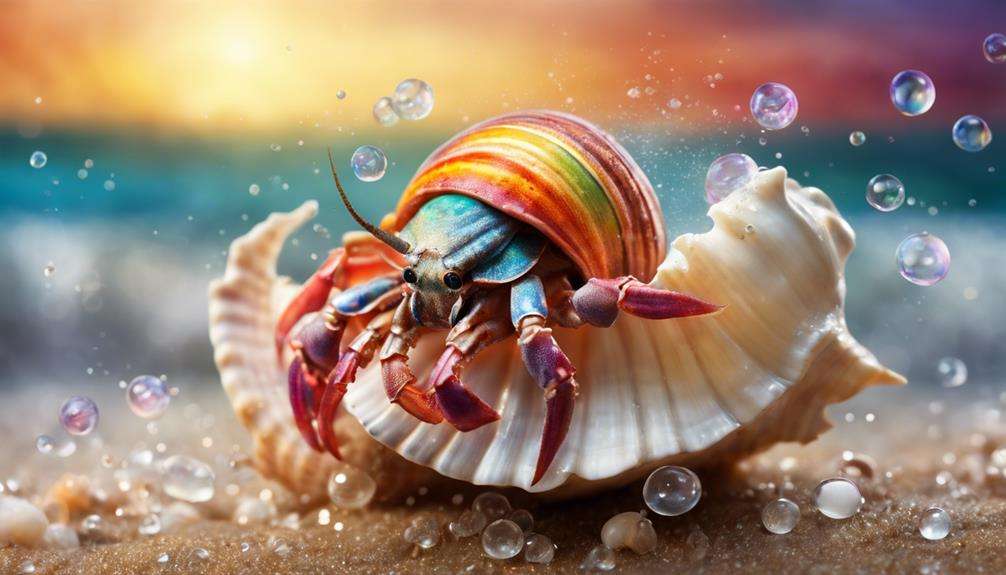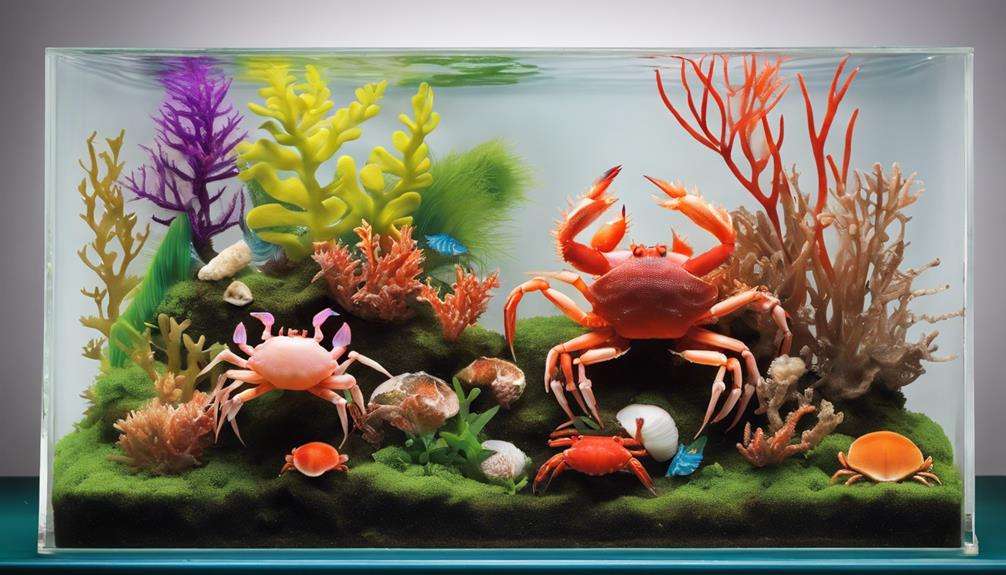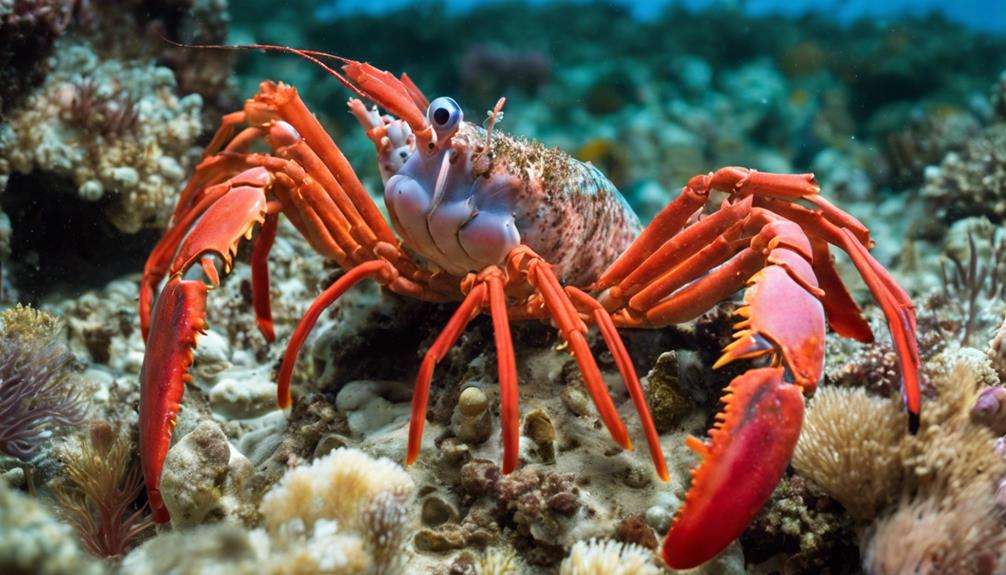Picture a miniature world beneath the water's surface, where vibrant colors dance and intricate creatures move with grace. Imagine a tiny crab, its claws delicately exploring its surroundings, adding a touch of the exotic to your small tank. These unique crustaceans offer not only a visual feast but also fascinating behaviors that can captivate any observer.
As you consider adding these small wonders to your aquatic setup, you'll discover a world of possibilities waiting to be explored.
Key Takeaways
- Fiddler Crabs and Thai Devil Crabs suit small tanks well with their vibrant colors and social behaviors.
- Red Claw Crabs and Freshwater Pom Pom Crabs offer visual appeal and unique features for compact tanks.
- Panther Crabs and Matano Crabs provide an exotic touch to small tank setups with their distinct characteristics.
- Vampire Crabs and Thai Micro Crabs offer intrigue and diversity, perfect for enthusiasts seeking unique additions in limited spaces.
Fiddler Crab
Fiddler crabs, known for their distinctive large claw resembling a fiddler's violin, require a 10-gallon tank with a habitat that includes both land and water to accommodate their unique behavior and lifestyle. These omnivorous creatures have a varied diet consisting of nutritional flakes, brine shrimp, blood worms, plankton, and seaweed. To mimic their natural habitat, the tank should have a mix of land and water, as fiddler crabs split their time between the two elements.
Within their social structure, fiddler crabs exhibit fascinating behavior, particularly in communication and courtship displays. The males use their disproportionately large claw to communicate with others and attract potential mates. This claw-waving behavior is a crucial aspect of their social interactions. Understanding and providing for these communication needs is essential for the well-being of fiddler crabs in captivity. By creating an environment that supports their natural behaviors, you can observe these captivating creatures thrive in your 10-gallon tank.
Thai Devil Crab
Originating from Southeast Asia, Thai Devil Crabs, scientifically known as Clariosoma Camifax, boast vibrant purple bodies and exhibit a peaceful demeanor with occasional aggression towards smaller tank mates. These crabs prefer a dry area in their habitat, making them unique additions to small tanks. Despite their peaceful nature, they can display aggression, especially towards tank mates of lesser size. Thai Devil Crabs are omnivorous, relishing a diet consisting of fresh and dried fruits, algae, nutritional flakes/pellets, and protein-based snacks.
In small tank setups, these colorful crustaceans stand out, adding a touch of vibrancy and interesting behavior. Their striking purple bodies make them visually appealing, enhancing the aesthetic of any aquatic environment. By providing a suitable environment with adequate hiding spots and a balanced diet, you can observe the fascinating behaviors of Thai Devil Crabs in your tank. Consider these fascinating creatures if you're looking to introduce a splash of color and activity into your small tank.
Vampire Crab
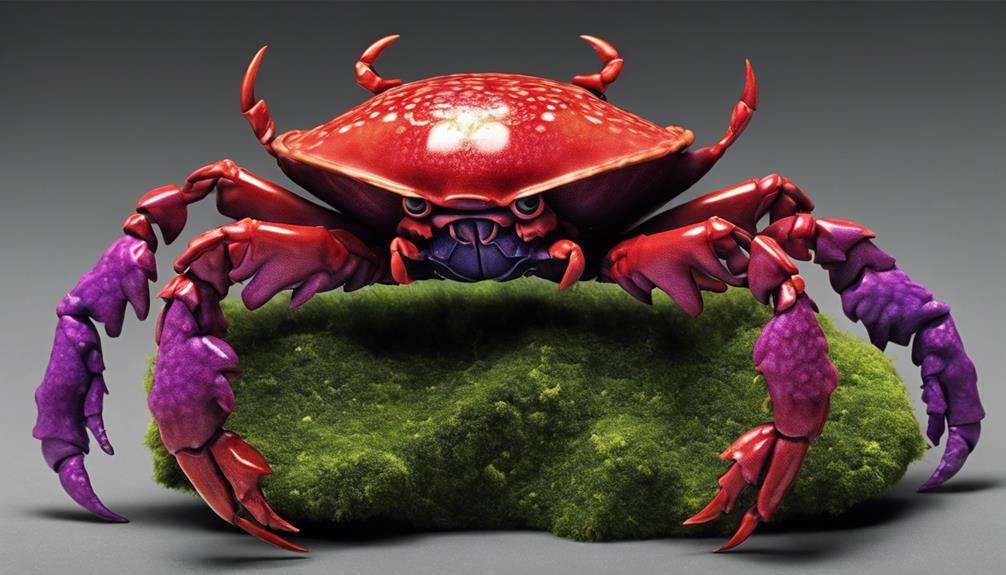
Vampire Crabs, scientifically known as Geosesarma dennerle, are fascinating crustaceans often sought after for their striking appearance and interesting behaviors.
These small creatures require a well-maintained habitat with proper humidity levels and hiding spots to thrive in captivity.
Providing a balanced diet, consisting of both plant matter and protein sources like insects, is crucial for the health and longevity of your Vampire Crabs.
Unique Vampire Crab
The Unique Vampire Crab, native to the Indonesian island of Java, boasts a stunning deep purple coat that sets it apart in small tank habitats. Here are some key characteristics of this captivating crustacean:
- Size: The Vampire Crab typically reaches a size of about 1.5 inches, making it ideal for small tanks.
- Diet: Being omnivorous, these crabs require a varied diet that includes plant matter and protein-based foods.
- Habitat: Vampire Crabs need a habitat that offers both land and water areas. They enjoy spending time on dry land but also require access to water to stay healthy and active.
These unique crabs with their deep purple coloration can add a touch of exotic allure to your tank setup.
Care Tips for Crabs
To properly care for Vampire Crabs in your tank, it's essential to create a multifaceted habitat that caters to their unique needs. These exotic crabs require a varied diet consisting of nutritional flakes, brine shrimp, bloodworms, and dried crickets to thrive. Given their territorial tendencies, it's crucial to provide hiding spots within the tank setup where they can retreat and feel secure.
Vampire Crabs, with their striking deep purple coats, exhibit nocturnal behavior, so ensure they've a dry area to rest during the day. Avoid housing them with large fish to prevent potential aggression towards the small crabs. By maintaining suitable habitat conditions and offering a diverse diet, you can ensure the well-being of your Vampire Crabs in a small tank.
Tank Setup Essentials
Setting up the ideal habitat for Vampire Crabs involves creating a diverse environment with both land and water elements to cater to their unique needs. To ensure your Vampire Crabs thrive in their tank setup, consider the following essentials:
- Land and Water Areas: Provide ample space for both land and water within the tank to allow the crabs to transition between the two environments freely.
- Climbing and Hiding Spaces: Include decorations like driftwood and rocks to create climbing structures and hiding spots, promoting natural behaviors and ensuring the crabs feel secure.
- Maintaining Humidity Levels: Regularly monitor and adjust humidity levels in the tank to mimic the crabs' natural habitat, aiding in their overall health and well-being.
Red Claw Crab
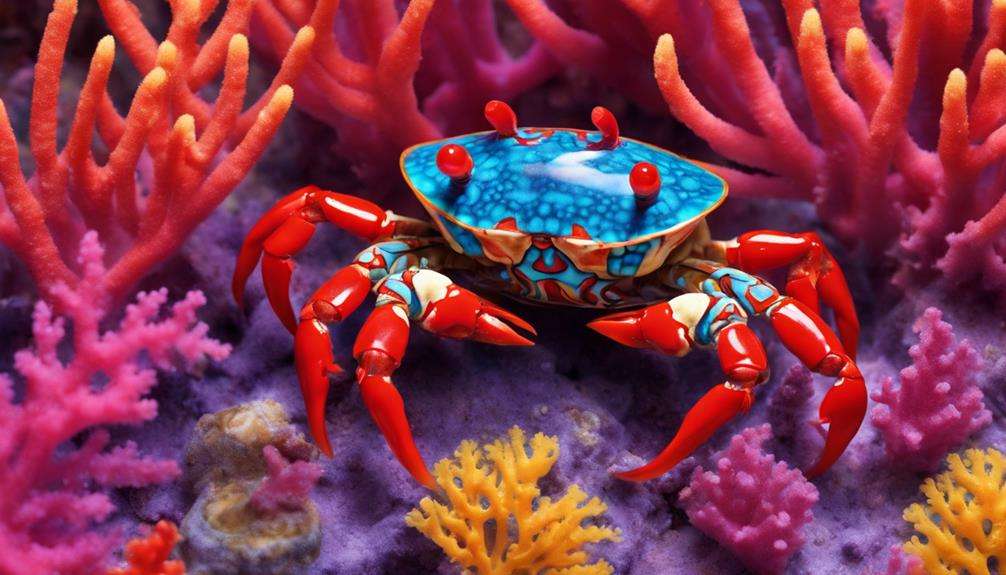
Red Claw Crabs, scientifically known as Sesarma bidens, are fascinating crustaceans commonly found in the Indo-Pacific region. These crabs can reach sizes of 2-3 inches in carapace width, showcasing their distinctive red claws.
Understanding their care requirements, tank setup essentials, and observing their unique behaviors are crucial aspects to consider when keeping Red Claw Crabs in your aquarium.
Care Tips for Crabs
When caring for Red Claw Crabs in your tank, ensure the water to land ratio is approximately 3:1 to meet their habitat requirements.
Here are some essential care tips for these freshwater crustaceans:
- Diet: Red Claw Crabs are omnivorous, so provide them with a balanced diet of fish food pellets/flakes and blanched vegetables to meet their nutritional needs.
- Size and Lifespan: These crabs can reach a size of 2-3 inches (5-8 cm) in carapace width and have a lifespan of up to 2-3 years in captivity when given proper care.
- Environment: Maintain a tank setup that mimics their natural habitat, including a water to land ratio of 3:1, to ensure they've space to swim and climb.
Tank Setup Essentials
To create an optimal habitat for Red Claw Crabs in your tank, ensure the water to land ratio is maintained at 3 to 1. Red Claw Crabs need hiding spots and soft sand for burrowing.
When setting up the tank, be cautious with live plants as they may be damaged by these crustaceans. While Red Claw Crabs can be initially shy, they thrive in lush environments with plant cover.
Providing a large tank is essential for these crabs to have ample space for their 'me-time' and to exhibit their natural behaviors. Remember, a well-designed tank setup with appropriate water to land ratio, hiding spots, and a suitable environment is crucial for the well-being of Red Claw Crabs in both small and large tanks.
Behavior and Habits
Maintaining a suitable habitat for Red Claw Crabs involves understanding their behavior and habits within the tank environment. Here are some essential points to consider:
- Diet: Red Claw Crabs are omnivorous creatures, enjoying a varied diet that includes fish food pellets/flakes, blanched vegetables, and brine shrimp. Ensuring their nutritional needs are met is crucial for their well-being.
- Behavior: Initially shy, these crabs may become more active and curious as they acclimate to their surroundings. Providing a stimulating environment can encourage natural behaviors and interactions within the tank.
- Habitat Requirements: Red Claw Crabs require a large tank with ample space for exploration. It's important to offer hiding spots and areas for retreat as these crustaceans can be sensitive to disturbances, ensuring they feel secure in their habitat. Their striking red claws add to their visual appeal, making them a captivating addition to any tank.
Panther Crab
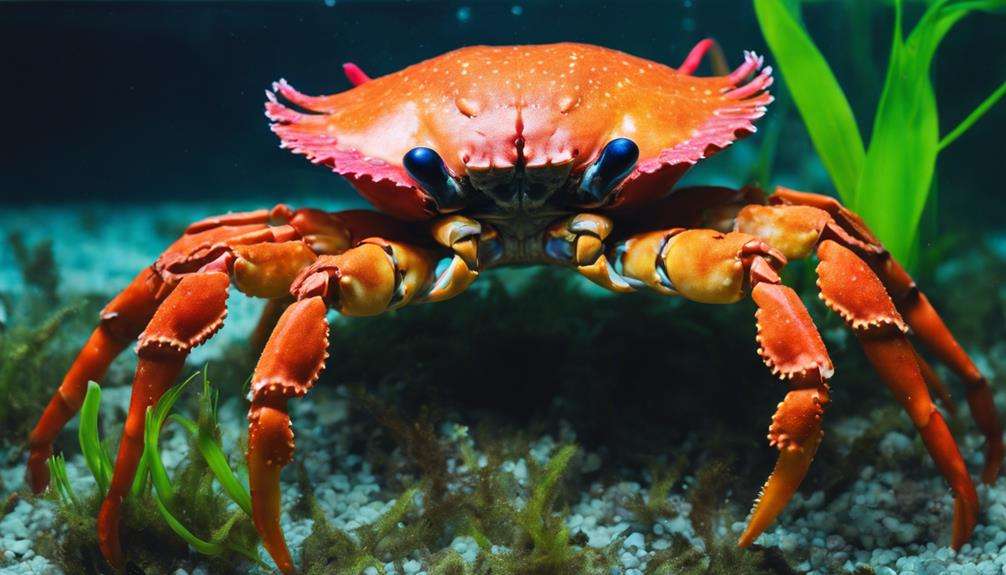
Originating from Indonesia, the Panther Crab (Parathelphusa Pantherina) showcases vibrant orange bodies adorned with distinctive black spots. These omnivorous crustaceans have a unique set of care requirements.
Panther Crabs are territorial and can exhibit aggressive behavior, especially towards tankmates. To cater to their needs, set up a tank that provides a mix of aquatic and terrestrial environments. This setup should include areas for them to both submerge and climb out of the water.
Panther Crabs communicate through body language, often using their claws to convey dominance or submission. Their diet should consist of brine shrimp, fish food pellets/flakes, dead plant material, and algae to ensure their nutritional needs are met.
When observing Panther Crabs, pay attention to their interactions with other tank inhabitants and provide hiding spots to reduce potential conflicts. By understanding their behaviors and meeting their dietary and environmental needs, you can create a suitable habitat for these captivating crustaceans.
Freshwater Pom Pom Crab
The Freshwater Pom Pom Crab, scientifically known as Lybia Edmondsoni, possesses distinctive 'pom poms' made of anemones held by its claws for defense. Here are some key points about this fascinating crab:
- Unique Appearance: Freshwater Pom Pom Crabs are part of the Xanthidae family and stand out due to the anemones they carry, resembling pom poms, which serve as a protective measure.
- Diet: To ensure optimal nutrition, these crabs require a diet consisting of high-quality sinking flakes or pellets, algae, and freeze-dried meaty foods. Providing a varied diet is crucial for their health.
- Behavior and Habitat: These crabs exhibit interesting behavior by using anemones for protection and camouflage. They thrive in tanks that offer ample hiding spots, live plants, and a mix of land and water areas to mimic their natural habitat effectively.
Keeping these aspects in mind will help you provide a suitable environment for your Freshwater Pom Pom Crab to thrive in your tank.
Thai Micro Crab
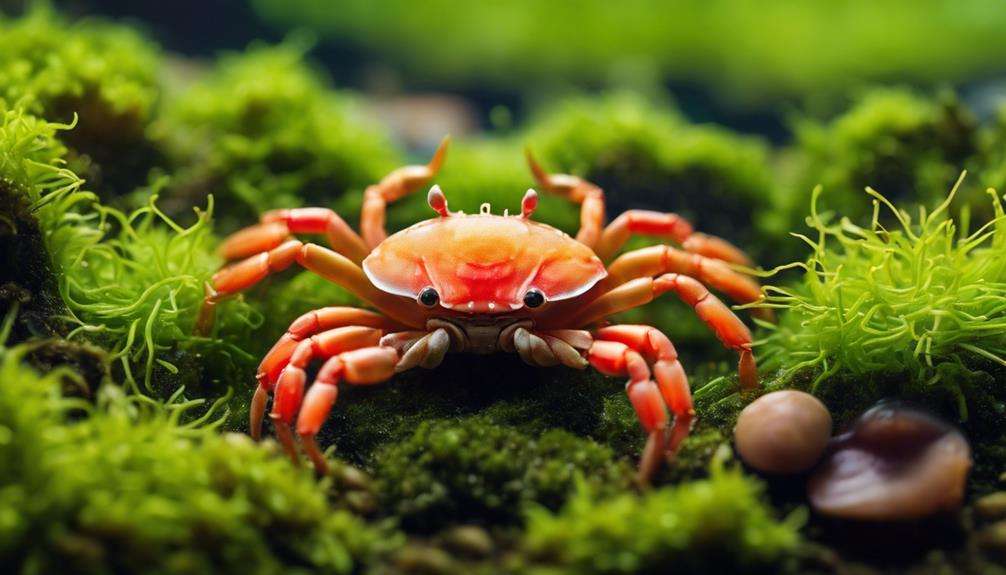
The Thai Micro Crab, scientifically referred to as Limnopilos naiyanetri, is a diminutive yet captivating crustacean species native to the Tha Chin River in Thailand.
With an average size of about 1 centimeter (0.4 inches), these crabs are perfectly suited for small tanks, adding a touch of uniqueness to your aquatic setup.
In their natural habitat, Thai Micro Crabs are omnivorous creatures, feeding on a diet that includes algae, biofilm, and decaying plant matter. When introduced to a freshwater tank, they exhibit a peaceful nature and can coexist harmoniously with other tank inhabitants.
These tiny crabs have a lifespan of up to 2 years in captivity, providing long-term enjoyment for aquarists. Adding Thai Micro Crabs to your freshwater tank not only enhances the biodiversity but also introduces an element of intrigue and fascination to your aquatic environment.
Matano Crab
Indigenous to Indonesia's Lake Matano, the Matano Crab, a member of the Gecarcinidae family, showcases a striking appearance and diverse dietary habits. Here's what you need to know about this unique crustacean:
- Omnivorous Diet: Matano Crabs have an omnivorous diet, consuming algae, dead organic matter, brine shrimps, and plant material. This varied diet contributes to their overall health and vitality.
- Size and Lifespan: Typically reaching a size of 2-2.5 inches (5-6.4 cm), these crabs are relatively small in size. In captivity, they boast a lifespan of 3-5 years, making them a long-term commitment for aquarists.
- Habitat Requirements: Matano Crabs thrive in environments with specific temperature and pH ranges. It's crucial to maintain these parameters in freshwater tanks to ensure the well-being of these fascinating creatures.
Considering their captivating appearance, intriguing behaviors, and adaptability to various aquatic conditions, Matano Crabs are an excellent choice for hobbyists looking to add a touch of uniqueness to their freshwater tanks.
Frequently Asked Questions
What Are the Easiest Crabs to Keep?
Thai Micro Crabs rank among the easiest crabs to keep, thriving in small tanks. Their omnivorous diet includes algae and plant matter. With proper care, these freshwater crabs from Thailand can live up to 2 years.
What Is the Least Aggressive Crab?
When considering the least aggressive crab species, you may find peace in the serene arrow crab. Known for their gentle demeanor, these calm crustaceans coexist well in community tanks, making them an easygoing choice for aquarists.
What Are the Small Crustaceans in My Fish Tank?
In your fish tank, small crustaceans like Thai Micro Crabs exhibit fascinating shrimp behavior. They coexist peacefully with tank mates, feeding on algae and biofilm. Maintain suitable water conditions, provide hiding spots, and observe their molting process for successful breeding. Engage in cleaning duties to ensure a healthy environment.
What Is the Best Pet Crab for Beginners?
For beginners, Thai Micro Crabs are the ideal pet crustaceans. Their small size, peaceful nature, and omnivorous diet make them a perfect addition to small tanks. Enjoy observing their interactions in a well-maintained aquarium environment.
Conclusion
In conclusion, exotic crustaceans perfect for small tanks offer a fascinating and colorful addition to any aquatic setup.
From the unique behaviors of the Thai Micro Crab to the vibrant colors of the Vampire Crab, these small crustaceans provide a delightful and low-maintenance option for freshwater crab enthusiasts.
With their compatibility with a variety of tank mates and specific habitat requirements, these exotic species can truly elevate the aesthetics and interest of a small tank environment.
